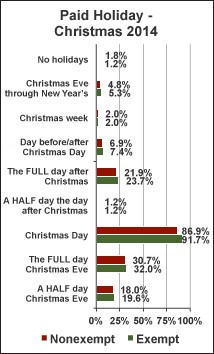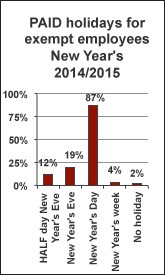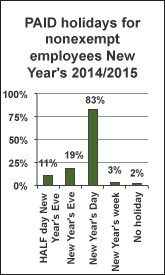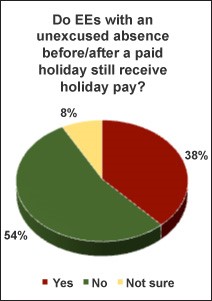The holidays are nearly upon us, and ’tis the season for our Holiday Practices Survey results. How does your organization compare with how others responded?
 |
Highlights of the 2014 Holiday Practices Survey:
- 7% offer employees their birthday as a paid day off
- 44.7% will offer 9 to 11 paid vacation days in 2015
- 87.3% offer New Year’s Day as a paid holiday to exempt employees and 82.6% offer it to nonexempt employees
- 53.9% do not provide holiday pay to employees who have an unexcused absence on the nearest workday before and/or after a company paid holiday
Thanks to all 2,666 individuals who participated in the survey! Here are the details:
The 2014 Holiday Season
Thanksgiving
When asked which days will be paid holidays for their employees at Thanksgiving in 2014, 93.2% of survey participants indicated that Thanksgiving Day will be a paid holiday for their exempt employees, and 88.4% indicated it would be a paid holiday for their nonexempt employees. Additionally, 67.2% will provide a paid day off to their exempt employees on the day after Thanksgiving, and 62.3% will provide the same to nonexempt employees.
The day before Thanksgiving is a paid holiday for 5% for both exempt and nonexempt employees. Exempt employees are allowed to use the day before Thanksgiving as a floating paid holiday for 6%, and 5.9% allow the same for nonexempt employees.
Christmas
For the 2014 Christmas season, 91.7% of survey respondents will provide December 25 as a paid holiday for exempt employees, and 86.9% will provide that same day for their nonexempt employees. Christmas Eve will be a paid holiday for exempt employees at 32% and nonexempt employees at 30.7%. Boxing Day, December 26, will be a paid holiday for exempt at 23.7% and for nonexempt at 21.9%.
Christmas week is a paid vacation for both exempt and nonexempt for 2% of survey participants (down from 3.3% in 2013). From Christmas Eve until New Year’s Day is offered as paid time off for exempt employees by 5.3% and for nonexempt employees by 4.8%.
No paid time off will be offered by 1.2% for exempt employees and by 1.8% for nonexempt employees.

Try BLR’s all-in-one compensation website, Compensation.BLR.com®, and get a complimentary special report, Top 100 FLSA Overtime Q&As, no matter what you decide. Find out more.
New Year’s
In 2013, 85.2% of survey participants offered New Year’s Day as a paid holiday, but 2014 paints a different picture with 87.3% offering it to exempt employees and 82.6% offering it to nonexempt employees. New Year’s Eve was provided as a paid holiday by 16.2% in 2013, but 19.2% will provide it to exempt employees, and 18.9% will offer it to exempt employees in 2014.


Up from 1.1% in 2013, 3.5% will provide New Year’s week (Monday, December 29 through Friday, January 2) as paid time off for exempt employees and 3.3% will provide it to nonexempt employees. No paid time off surrounding New Year’s will be provided to exempt employees by 1.8% and to nonexempt employees by 2.3%.
On to 2015—Paid Holidays
How Many Holidays?
When asked how many paid holidays their employees will receive in 2015, survey participants indicated the following:
Number of Holidays for 2015
| Number of paid holidays |
Response percent |
|
1–5 days |
3.4% |
|
6–8 days |
37.5% |
|
9–11 days |
44.7% |
|
12 or more days |
13.8% |
|
No paid holidays |
0.1% |
In addition to paid companywide holidays, 28.7% provide floating holidays to be used at employees’ discretion. Of those, 40.2% will provide one floating holiday, 29.3% will provide two, 15.6% will provide three, and 14.9% will provide more than three floating holidays.
Which Holidays?
Memorial Day, Independence Day, Labor Day, Thanksgiving Day, Christmas Day, and New Year’s Day will be offered as paid holidays by at least 93% of survey participants in 2015.
Martin Luther King Jr. Day and Presidents’ Day will be paid holidays for 32.6% and 33.3%, respectively. Columbus Day is a paid day off for 14.1%, and Boxing Day will qualify as a paid holiday for 12.1% (up from 9.2% in 2014 and 4.3% in 2013). Veterans Day will be a paid holiday for 20%, and employees’ birthdays will be a paid day off for 7%.
Try BLR’s all-in-one compensation website, Compensation.BLR.com®, and get a complimentary special report, Top 100 FLSA Overtime Q&As, no matter what you decide. Find out more.
Holiday Practices
Holiday Pay
Nonexempt employees do not work on holidays for 24.6% of survey participants. Nonexempt employees do work on holidays and receive holiday pay plus time and a half for hours worked for 9.6%, and 2.2% pay holiday pay plus double time. Only regular pay is received for 25.3%, and another day off with pay is the norm for 5.8%. When it comes to holiday pay for employees who have an unexcused absence on the nearest workday before and/or after a company-paid holiday, 53.9% of survey participants do not provide holiday pay.

First Dibs
When it comes to deciding which employees get priority in deciding their days off during the holidays, 15.5% leave it up to the supervisor, and 12.4% go with whoever asks first. It’s not a problem and everyone gets what he or she wants for 3.7%, but for 3.8%, employees take turns from year to year. A formal system based on seniority is in place for 6.9%, and 7% use an informal seniority/ranking system. The business is closed for 36%.
Unrecognized Holidays
Less than 5% of employees use paid time off for religious days not recognized as paid holidays for 39.2% of survey participants, and no employees use such time for 19.8%.
In tomorrow’s Advisor, more results of the 2014 Holiday Practices Survey, plus we introduce the all-things-compensation-in-one-place website, Compensation.BLR.com®.

Very interesting about not paying holiday pay to employees with unexcused absences around the holiday! I’d love to know if that’s effective.